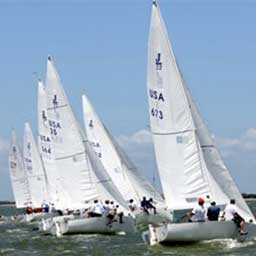Certification Requirements: The Performance Sailing Certification requires the successful completion of all of the following knowledge and skill requirements. This course will help you learn to analyze, adjust, and shape your sails for maximum speed. How to adjust the boats backstay and jib leads for optimum performance. This course brings your keelboat sailing skills to a new level without moving up to a bigger boat.
Prerequisite: US Sailing Basic Keelboat Certification.
Practical Skills
Preparation to Sail:
- Demonstrate ability to recognize and forecast prevailing local weather conditions.
- Perform an inspection of running rigging, standing rigging, and hull integrity.
- Demonstrate an understanding of basic rig tuning including rake and shroud adjustment.
Crew Operations and Skills:
- Demonstrate winch operation and proper procedures for clearing a fouled winch.
- Demonstrate tying and use of knots: clove hitch, sheet bend, and rolling hitch. Review stopper knot, bowline, cleat hitch, round turn and two half hitches, square knot.
- Demonstrate how to heave a line.
- Demonstrate the use of these sail controls: boom vang, adjustable backstay, adjustable jib fairlead, traveler, leech line, outhaul, halyard, sheet tension and how they affect sail shape in terms of draft or camber to chord.
Leaving the Dock or Mooring:
- Demonstrate the use of dock lines, including spring lines, for boat control while departing
Boat Control in Confined Water:
- Demonstrate controlling the boat’s course with the use of sail trim and weight placement by sailing around a predetermined buoyed without the use of a rudder for steering.
- Demonstrate a mooring landing under sail.
- Demonstrate ability to maneuver under sail in close quarters: short tacking and controlled jibes.
- Demonstrate proper trim and steering methods while changing direction around a buoy from broad reaching to a close hauled course.
Navigating (Pilotage):
- Demonstrate the ability to hold a fixed compass course on a downwind point of sail to a predetermined destination.
- By using a compass and/or land bearings on a close hauled course, identify wind shifts.
Boat Control in Open Water:
- Demonstrate proper sail trim for the given wind conditions by shaping the mainsail using all adjustable sail controls. Identify draft position in both mainsail and headsail and the ability to move the draft to different locations on the sail.
- Using the mainsheet, traveler, and boom vang, adjust the mainsail upwind correctly for the given wind speed.
- Identify the leech shape in both the headsail and mainsail using telltales and battens when appropriate.
- Demonstrate steering a close hauled course by using jib telltales.
- Identify puffs and lulls by looking at the water and by recognizing changes in boat performance.
- Demonstrate balancing the boat through proper weight placement both fore and aft and side to side in light, moderate, and heavy wind and sea conditions.
Heavy Weather Sailing:
- Demonstrate a broach and recovery and/or discuss and walk through this procedure.
- Demonstrate shaping the sails for heavy weather sailing using all adjustable sail controls.
- Demonstrate reefing while underway on a close hauled course.
Anchoring Techniques:
- Anchor the boat without using auxiliary power. This includes preparing the anchor, identifying a safe anchorage, dropping anchor and checking for the anchor holding fast.
- Leave an anchorage area safely under sail. This includes preparing the boat to be sailed, raising the anchor, properly stowing the anchor while underway, and safely sailing away from the anchorage area.
Returning to the Dock or Mooring:
- Execute three safe docking and/or mooring landing under sail approaching the area from upwind, downwind, and crosswind or by using different landing areas to complete the skill.
Securing the Boat Properly:
- Demonstrate the stowing of the mainsail by two methods: rolling the sail & stowing, flaking the sail on the boom and securing.
- Demonstrate correct use and deployment of docklines and spring lines.
- Demonstrate how to secure a boat to its dock space or mooring in the event of high winds, large tidal change or a storm. This procedure would include demonstrating how to tie additional dock lines including spring lines, fender placement and moving the boat away from prevailing wind in its dock slip orientation.
Knowledge
Preparation to Sail:
- Discuss the influence of local weather patterns on sailing.
- Describe areas on a boat which should be inspected every time for integrity prior to sailing.
Crew Operations and Skills:
- Explain how to changing the length of both upper and lower shrouds and the forestay effects the shape and position of the mast. Relate this to how mast shape affects sail shape.
- Describe how each side of a mainsail and headsail can be shaped through the use of sail controls.
Sailing Theory:
- Describe sailboat dynamics: center of effort, center of lateral resistance, and effects and influences of lee and weather helm.
- Describe a powered up vs. a depowered sail shape and in what wind/sea condition each is most effectively used.
- Explain when to use open and closed leech shapes.
- Discuss lifts and headers and when each can be advantageous to your upwind course.
- Describe how changes in wind velocity can affect steering on a close hauled course.
- Explain how changing the trim of a mainsail and headsail affect how a boat steers through the water.
- Explain how weight placement on a boat, both side to side and fore and aft, will affect boat speed.
Navigation (Piloting):
- Describe ways to determine the direction of current flow in your sailing area. Discuss how to use this information to help plan the most efficient sailing route in point to point sailing. Also discuss how current flow influences your dock departure, landings, and in navigating courses in confined or congested waters.
Boat Control in Open Water:
- Discuss the concept of draft in sails. Understand how draft can be changed in a sail and how and and why to move draft for better boat balance and control.
- Explain how the boom vang, traveler, and mainsheet interact for creating optimum mainsail trim.
Heavy Weather Sailing:
- Describe the causes of a broach. Explain the theory of how to recover from broaching and the sequence of events to follow to recover from a broach and continue sailing.
- Review the sequence for reefing a mainsail while underway.
Safety and Emergency Procedures:
- Describe recovery methods after going aground.
- Understand towing techniques, maneuvering onto a tow, handling and securing a tow line, chafing protection, boat speed, dropping off a tow, and communications.
Anchoring Techniques:
- Describe how to locate a safe anchorage and procedures for anchoring a boat from under sail.
Returning to the Dock or Mooring:
- Describe the considerations to take when selecting a dock or mooring on which to land. Include landing and exit strategies for successful and unsuccessful docking attempts.
Securing the Boat Properly:
- Understand the precautions which need to be taken for securing your boat at a dock or mooring during periods of storms, high winds, or large tidal changes.
- Explain further procedures you would follow to secure your boat during extreme weather conditions such as gales or hurricanes.









